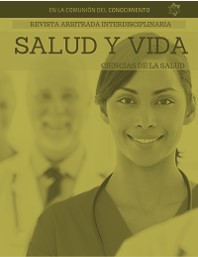Estimation of ergonomic risks in neonatology personnel
DOI:
https://doi.org/10.35381/s.v.v6i2.2043Keywords:
Recién nacido, enfermería, ergonomía. (Fuente, DeCS).Abstract
Objective: To estimate the ergonomic risks of the nursing staff of the Neonatology service in Tena hospital, in the month of May 2021. Methods: Descriptive observational study. Results: 70.4% of the cases did not receive pharmacological or physiotherapeutic treatment before the appearance of the complaints. In turn, 90.7% reported that the causes were associated with the work activity. Conclusion: The main ergonomic risks identified were associated with the adoption of postures in which one or more parts of the body remain static, and the assumption of unstable postures. All cases were found to be exposed to medium to high ergonomic risk levels, requiring action in all cases, and immediate action in a smaller number of cases. Musculoskeletal symptoms were mostly in the neck, back, wrists and hands, as well as in the shoulders.
Downloads
References
Cercado Bajaña MM, Chinga Carreño GP, Soledispa Rodríguez XE. Riesgos ergonómicos asociados al puesto de trabajo del personal administrativo [Ergonomic risks associated with the work place of administrative personnel]. Rev. Publicando [Internet 2021;8(32):69-81. Disponible en: https://revistapublicando.org/revista/index.php/crv/article/view/2268
Pereira Gomes L, Días da Silva G, Domínguez F. Impacto del lumbago en la calidad de vida de los trabajadores: una búsqueda sistemática [The impact of low back pain on workers quality of life: a systematic review]. Salud de los Trabajadores [Internet]. 2016; 24(1): 59-62.
Ryu E, Ye B, Yi Y, Kim J. Risk factors of musculoskeletal symptoms in university hospital nurses. Ann Occup Environ Med. 2014;26(1):47. Published 2014 Nov 4. doi:10.1186/s40557-014-0047-7
Jhun HJ, Cho SI, Park JT. Changes in job stress, musculoskeletal symptoms, and complaints of unfavorable working conditions among nurses after the adoption of a computerized order communication system. Int Arch Occup Environ Health. 2004;77(5):363-367. doi:10.1007/s00420-004-0509-2
Gerr F, Fethke NB, Anton D, et al. A prospective study of musculoskeletal outcomes among manufacturing workers: II. Effects of psychosocial stress and work organization factors. Hum Factors. 2014;56(1):178-190. doi:10.1177/0018720813487201
Lindegård A, Wahlström J, Hagberg M, Vilhelmsson R, Toomingas A, Tornqvist EW. Perceived exertion, comfort and working technique in professional computer users and associations with the incidence of neck and upper extremity symptoms. BMC Musculoskelet Disord. 2012;13:38. Published 2012 Mar 21. doi:10.1186/1471-2474-13-38
Soler-Font M, Ramada JM, van Zon SKR, et al. Multifaceted intervention for the prevention and management of musculoskeletal pain in nursing staff: Results of a cluster randomized controlled trial. PLoS One. 2019;14(11):e0225198. Published 2019 Nov 18. doi:10.1371/journal.pone.0225198
Serra C, Soler-Font M, García AM, Peña P, Vargas-Prada S, Ramada JM. Prevention and management of musculoskeletal pain in nursing staff by a multifaceted intervention in the workplace: design of a cluster randomized controlled trial with effectiveness, process and economic evaluation (INTEVAL_Spain). BMC Public Health. 2019;19(1):348. Published 2019 Mar 28. doi:10.1186/s12889-019-6683-7
Rasmussen CDN, Hendriksen PR, Svendsen MJ, et al. Improving work for the body - a participatory ergonomic intervention aiming at reducing physical exertion and musculoskeletal pain among childcare workers (the TOY-project): study protocol for a wait-list cluster-randomized controlled trial. Trials. 2018;19(1):411. Published 2018 Jul 31. doi:10.1186/s13063-018-2788-z
Rasmussen CDN, Sørensen OH, van der Beek AJ, Holtermann A. The effect of training for a participatory ergonomic intervention on physical exertion and musculoskeletal pain among childcare workers (the TOY project) - a wait-list cluster-randomized controlled trial. Scand J Work Environ Health. 2020;46(4):429-436. doi:10.5271/sjweh.3884
Tipantuña Malte P, Reyes Miguel W, Paredes Aguirre A. Relación entre conocimientos, actitudes y prácticas en la prevención de los riesgos ergonómicos de los profesionales de enfermería de la Clínica Good Hope, Lima, 2016 [Relationship between knowledge, attitudes and practices in the prevention of ergonomic risks of nursing professionals at the Good Hope Clinic, Lima, 2016]. RCCS [Internet]. 2017; 10(1). Disponible en: https://revistas.upeu.edu.pe/index.php/rc_salud/article/view/218
Solís, A. Evaluación de los riesgos ergonómicos en los camilleros del área de Emergencia de un hospital general de Manabí [Evaluation of ergonomic risks in the stretcher-bearers of the Emergency area of a general hospital in Manabí]. [Internet]: 2021. http://repositorio.sangregorio.edu.ec/handle/123456789/2137
Tandazo, R. E. Posturas forzadas en el personal femenino auxiliar de enfermería en el manejo de pacientes críticos del área de emergencia de un hospital de Quito [Forced postures in female auxiliary nursing staff in the management of critical patients in the emergency area of a hospital in Quito]. [Internet] 2021. Obtenido de https://repositorio.uisek.edu.ec/handle/123456789/4164
Pincay Vera M, Chiriboga Larrea G, Vega F. Posturas inadecuadas y su incidencia en trastornos músculo esqueléticos [Improper posture and its incidence in muscle-skeletal disorders]. Rev Asoc Esp Espec Med Trab [Internet]. 2021; 30(2): 161-168.
Sundstrup E, Jakobsen MD, Andersen CH, et al. Participatory ergonomic intervention versus strength training on chronic pain and work disability in slaughterhouse workers: study protocol for a single-blind, randomized controlled trial. BMC Musculoskelet Disord. 2013;14:67. Published 2013 Feb 21. doi:10.1186/1471-2474-14-67
Published
How to Cite
Issue
Section
License
CC BY-NC-SA : Esta licencia permite a los reutilizadores distribuir, remezclar, adaptar y construir sobre el material en cualquier medio o formato solo con fines no comerciales, y solo siempre y cuando se dé la atribución al creador. Si remezcla, adapta o construye sobre el material, debe licenciar el material modificado bajo términos idénticos.
OAI-PMH: https://fundacionkoinonia.com.ve/ojs/index.php/saludyvida/oai.









